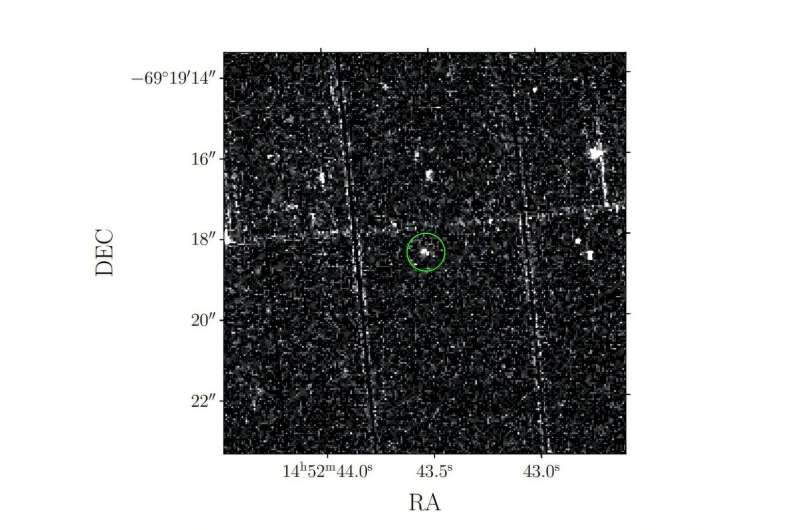Science
Astronomers Discover New Long-Period Radio Transient ASKAP J1448−6856

An international team of astronomers has reported the discovery of a new long-period radio transient designated as ASKAP J144834−685644, or ASKAP J1448−6856 for short. This significant finding was detailed in a paper published on July 17, 2025, on the arXiv preprint server, contributing to the still limited catalog of long-period radio transients (LPTs).
Long-period radio transients are an emerging category of periodic radio emitters characterized by ultralong rotation periods that can range from minutes to hours, alongside exceptionally strong magnetic fields. While some studies have suggested a link to rotating neutron stars, known as magnetars, or magnetic white dwarfs, the exact nature of these transients remains elusive to astronomers.
The discovery was made using the Australian Square Kilometre Array Pathfinder (ASKAP), a 36-dish radio interferometer based in Australia, operating within a frequency range of 700 to 1,800 MHz. One of ASKAP’s primary objectives is to detect and monitor transient and variable sources across the radio sky. Leading the research team, Akash Anumarlapudi from the University of Wisconsin–Milwaukee, identified this new transient by searching for circularly polarized sources, ultimately pinpointing one with highly variable linear and circular polarization emissions.
In their published findings, the researchers state, “We report the discovery of a new LPT, ASKAP J1448−6856. Discovered as a 1.5-hour periodic radio source, ASKAP J1448−6856 shows a steep spectrum, elliptical polarization, and periodic narrowband emission that declines at frequencies above 1.5 GHz.”
The new transient exhibits a complex emission pattern, featuring a harmonic frequency structure and polarized bursts. Its emissions are elliptically polarized, with the polarization fraction fluctuating between 35% and 100% across different observations. Significantly, unlike most other LPTs, ASKAP J1448−6856 has been detected across various wavelengths, from X-rays to radio, and displays variability in optical bands. This identification positions it among the few LPTs recognized across such a broad spectrum.
According to the researchers, multiwavelength modeling of the spectral energy distribution (SED) of ASKAP J1448−6856, along with its radio characteristics, suggests it may represent a near-edge-on magnetic white dwarf (MWD) binary system boasting a magnetic field strength exceeding 1,000 Gauss. Nevertheless, the authors do not rule out the possibility that ASKAP J1448−6856 could also be an isolated white dwarf pulsar or a system resembling a transitional millisecond pulsar.
In summarizing the results, the scientists emphasized the importance of this discovery for enhancing the understanding of the LPT population. “Combining ASKAP J1448−6856 with the growing number of long-period radio transients adds to the variety of multi-wavelength behavior and will help deepen our understanding of this emerging population (or, indeed, populations),” the researchers concluded.
As the field of astrophysics continues to expand, discoveries like ASKAP J1448−6856 highlight the collaborative efforts of scientists and the sophisticated technology utilized to explore the mysteries of the universe.
This article draws upon the study led by Akash Anumarlapudi et al., titled “ASKAP J144834-685644: a newly discovered long period radio transient detected from radio to X-rays,” available on arXiv.
-

 Health3 months ago
Health3 months agoNeurologist Warns Excessive Use of Supplements Can Harm Brain
-

 Health3 months ago
Health3 months agoFiona Phillips’ Husband Shares Heartfelt Update on Her Alzheimer’s Journey
-

 Science1 month ago
Science1 month agoBrian Cox Addresses Claims of Alien Probe in 3I/ATLAS Discovery
-

 Science1 month ago
Science1 month agoNASA Investigates Unusual Comet 3I/ATLAS; New Findings Emerge
-

 Science4 weeks ago
Science4 weeks agoScientists Examine 3I/ATLAS: Alien Artifact or Cosmic Oddity?
-

 Entertainment4 months ago
Entertainment4 months agoKerry Katona Discusses Future Baby Plans and Brian McFadden’s Wedding
-

 Science4 weeks ago
Science4 weeks agoNASA Investigates Speedy Object 3I/ATLAS, Sparking Speculation
-

 Entertainment4 months ago
Entertainment4 months agoEmmerdale Faces Tension as Dylan and April’s Lives Hang in the Balance
-

 World3 months ago
World3 months agoCole Palmer’s Cryptic Message to Kobbie Mainoo Following Loan Talks
-

 Science4 weeks ago
Science4 weeks agoNASA Scientists Explore Origins of 3I/ATLAS, a Fast-Moving Visitor
-

 Entertainment4 months ago
Entertainment4 months agoLove Island Star Toni Laite’s Mother Expresses Disappointment Over Coupling Decision
-

 Entertainment3 months ago
Entertainment3 months agoMajor Cast Changes at Coronation Street: Exits and Returns in 2025









